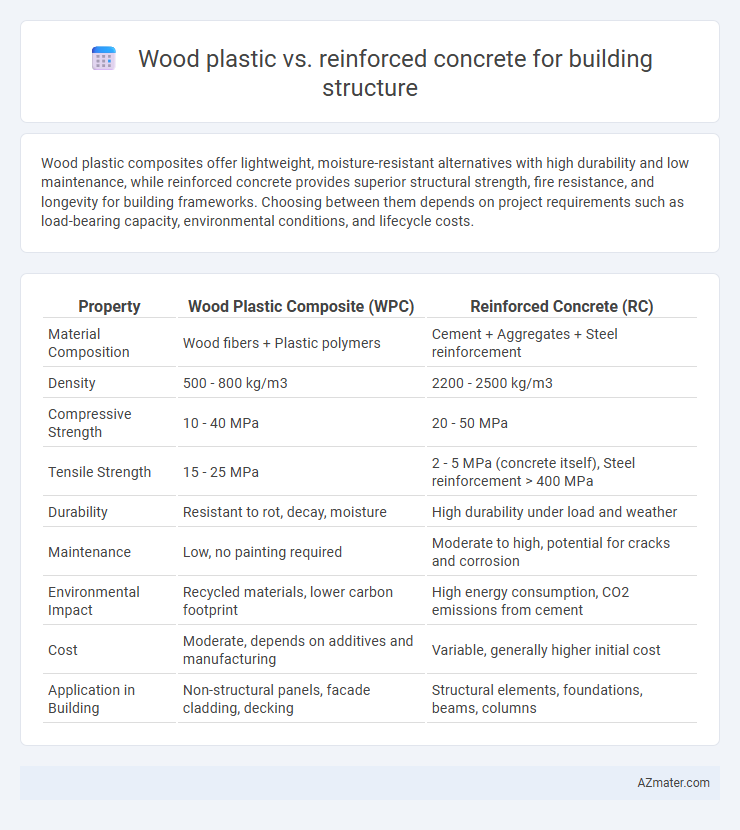Wood plastic composites offer lightweight, moisture-resistant alternatives with high durability and low maintenance, while reinforced concrete provides superior structural strength, fire resistance, and longevity for building frameworks. Choosing between them depends on project requirements such as load-bearing capacity, environmental conditions, and lifecycle costs.
Table of Comparison
| Property | Wood Plastic Composite (WPC) | Reinforced Concrete (RC) |
|---|---|---|
| Material Composition | Wood fibers + Plastic polymers | Cement + Aggregates + Steel reinforcement |
| Density | 500 - 800 kg/m3 | 2200 - 2500 kg/m3 |
| Compressive Strength | 10 - 40 MPa | 20 - 50 MPa |
| Tensile Strength | 15 - 25 MPa | 2 - 5 MPa (concrete itself), Steel reinforcement > 400 MPa |
| Durability | Resistant to rot, decay, moisture | High durability under load and weather |
| Maintenance | Low, no painting required | Moderate to high, potential for cracks and corrosion |
| Environmental Impact | Recycled materials, lower carbon footprint | High energy consumption, CO2 emissions from cement |
| Cost | Moderate, depends on additives and manufacturing | Variable, generally higher initial cost |
| Application in Building | Non-structural panels, facade cladding, decking | Structural elements, foundations, beams, columns |
Introduction to Wood Plastic and Reinforced Concrete
Wood plastic composites combine natural wood fibers with thermoplastics, offering enhanced durability, resistance to decay, and reduced maintenance compared to traditional wood. Reinforced concrete consists of concrete embedded with steel reinforcement bars, providing exceptional compressive strength and tensile resistance essential for heavy load-bearing structures. Both materials serve distinct roles in construction, with wood plastic favored for lightweight, flexible applications and reinforced concrete for high-strength structural components.
Material Composition and Properties
Wood plastic composites (WPC) consist of wood fibers or flour combined with thermoplastic polymers such as polyethylene or polypropylene, offering lightweight, corrosion-resistant, and flexible properties. Reinforced concrete comprises cement, aggregates, water, and steel reinforcement bars, delivering high compressive strength, durability, and fire resistance with excellent load-bearing capacity. While WPC emphasizes sustainability and ease of installation, reinforced concrete is preferred for structural stability and longevity in heavy-load applications.
Structural Strength and Load-Bearing Capacity
Wood plastic composites (WPC) offer moderate structural strength, suitable for light to medium load-bearing applications, but they generally lack the high tensile and compressive strength found in reinforced concrete. Reinforced concrete provides superior load-bearing capacity due to the combination of concrete's compressive strength and steel reinforcement's tensile strength, making it ideal for heavy structural elements. The durability and rigidity of reinforced concrete surpass WPC, especially in high-stress environments where long-term structural integrity is critical.
Durability and Longevity
Wood plastic composites (WPC) offer high resistance to moisture, rot, and insect damage, contributing to prolonged durability in various environmental conditions. Reinforced concrete, known for its exceptional compressive strength and resistance to fire, provides superior structural longevity, often exceeding 50 years under proper maintenance. While WPCs resist surface degradation, reinforced concrete maintains integrity under heavy loads and extreme weather, making it preferable for foundational and high-stress building components.
Environmental Impact and Sustainability
Wood plastic composites (WPC) offer a lower environmental footprint compared to reinforced concrete due to their use of recycled plastics and renewable wood fibers, which reduce landfill waste and deforestation. Reinforced concrete production generates significant carbon emissions primarily from cement manufacturing, contributing heavily to global CO2 levels. WPC's durability, moisture resistance, and recyclability enhance sustainability in building structures by minimizing resource extraction and promoting circular economy practices.
Cost Analysis and Economic Considerations
Wood plastic composites offer lower upfront material costs and faster installation times compared to reinforced concrete, making them economically attractive for smaller-scale or modular building projects. Reinforced concrete, while more expensive initially due to complex formwork and curing times, provides superior durability and longevity, potentially reducing long-term maintenance and replacement expenses. Evaluating lifecycle costs, including factors like thermal insulation, environmental impact, and load-bearing capacity, is essential for choosing the most cost-effective structural material for specific construction applications.
Construction Speed and Ease of Installation
Wood plastic composites offer faster construction speed and ease of installation compared to reinforced concrete due to their lighter weight and prefabricated components, reducing labor intensity and on-site adjustments. Reinforced concrete requires extensive curing time and heavy machinery for installation, often delaying project timelines. Prefabricated wood plastic panels enhance modular construction methods, significantly shortening assembly duration in building structures.
Maintenance Requirements and Lifespan
Wood plastic composites require minimal maintenance due to their resistance to rot, insects, and weathering, often needing only periodic cleaning and occasional inspections. Reinforced concrete demands regular checks for cracks, corrosion of steel reinforcement, and potential water damage to prevent structural deterioration. Lifespan of reinforced concrete typically exceeds 50 years with proper upkeep, while wood plastic composites can last 25-30 years depending on environmental exposure and quality.
Design Flexibility and Architectural Potential
Wood plastic composites offer superior design flexibility due to their lightweight nature and ease of shaping, enabling innovative architectural forms and intricate detailing not easily achievable with reinforced concrete. Reinforced concrete provides robust structural integrity and high load-bearing capacity but is limited in design versatility because of its rigid formwork and curing constraints. Choosing wood plastic composites enhances architectural potential through modularity and adaptability, while reinforced concrete excels in durability and large-scale structural applications.
Suitability for Various Building Applications
Wood plastic composites offer excellent resistance to moisture and corrosion, making them suitable for exterior cladding, decking, and light structural elements in residential and commercial buildings. Reinforced concrete provides superior compressive strength and durability, ideal for high-load-bearing applications such as foundations, columns, and large-scale infrastructure projects. Selection depends on project requirements, with wood plastic favored for eco-friendly, lightweight structures and reinforced concrete preferred for longevity and heavy-duty support.

Infographic: Wood plastic vs Reinforced concrete for Building Structure
 azmater.com
azmater.com